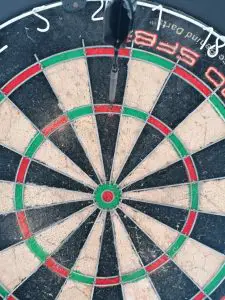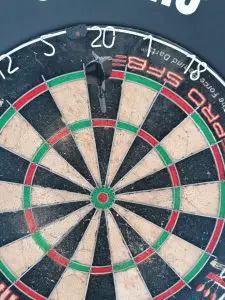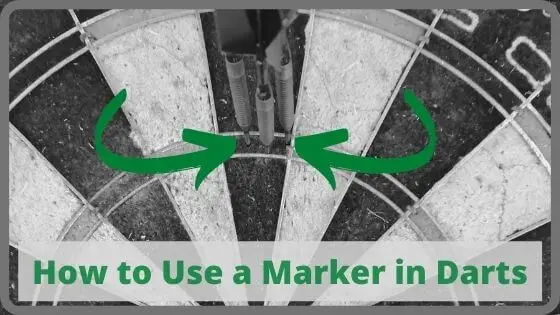Darts is a game of skill or accuracy, but as humans, whenever we look to aim at something we usual visual cues to guide us. Lines painted onto roads help us to stay in lanes when driving, the darts throw line helps us know where to stand when throwing the dart, and missed darts can be used as a very effective guide.
When throwing at a number, a missed dart can be frustrating for most people, but the best players use these missed darts to help guide their next throw. This missed dart is better known as a marker and a marker could be key to helping you improve your finishing in darts.
Read on to find out how to use a marker in darts for improved finishing and consistency with your throws.
What Is a Marker in Darts
Anyone watching a game of darts is likely to hear the commentators say something like:
“That’s a good marker”
“That was a close miss but they’ve left a good marker”
Well, what is a marker in darts?
A marker in darts is a missed dart, usually landing above a double outside of the scoring area, that is used as a guide or target for your next dart. A marker in darts acts as a visual guide and gives you something to aim for in order to make the minor adjustment needed to hit your target double (or number).
The best way to consider a marker is to look at the treble 20. If your dart lands slightly high up like in the image below then you’ll now have a very noticeable target to which you can aim your next dart.

The theory, reasoning, or justification for this is that if you throw at the dart (with a slight focus of trying to land below it) then this will give a better mental focus and will also enhance your aim as you can look at a fixed point on the dartboard.
When throwing for a double in general, you will still be focusing on a point but as a segment is wide, it’s difficult to focus on one exact point. A dart on the other hand is a fixed point that’s hitting the board with a maximum width of around 1 inch.
This means when aiming for that, you are actually aiming for a very specific area as opposed to a more general one. Therefore, a marker in darts is simply a dart that gives you a defined and clear area to aim for with the intention of this to better focus on the target segment – typically a double.
It’s not just a double that a marker is useful for though, when throwing at a treble, a marker is great for grouping your darts and enhancing your scoring. Darts practice rings follow the concept of having a visual area for you to focus on rather than getting distracted by looking at the treble bed.

Your first dart (if it lands favorably) can therefore also be used as a marker for your next follow-up darts to improve grouping and in most cases, improve your scoring potential and ability.
How to Use a Marker in Darts
To use a marker in darts, you’ll need to focus on the angle that your dart hits the board initially. If you throw with the dart hitting the board with the tip pointing down at around a 20-degree angle, your markers will always need to be above the target segment.

If you throw a relatively flat dart or one with the tip pointing upward at around a 20 degrees, you’ll need a marker to be below the target segment.

In both instances, if you throw a dart that blocks the target number, this won’t be a marker and will instead require a cover shot.
To use a marker in darts, you need the dart to land close to the wire of your target segment (double or treble). If the dart lands too far away, you won’t be able to use it as marker. Once the dart is within a ½ inch of the target segment, you should then throw your next dart at the marker.
Trying to hit the marker seems like something that will just lead to a bounce-out but a marker is used as a deflection point by the pros. If you hit the marker then there’s a good chance you’ll deflect slightly into the intended double or treble.
Tips for Using a Marker in Darts
If you’re not used to using a marker in darts then the following are some tips you should keep in mind – some may be a little obvious but if you’re a complete beginner then they may still be helpful.
- If your dart lands angled with the tip pointing down, the marker will need to be above the target segment. If the dart lands below the segment with the dart tip pointing down, then this will block the bed and can’t be used as a marker.
- If your dart lands angled with the tip pointing up, the marker will need to fall below the target segment. If the dart lands above the segment with the dart tip point up, then this will block the bed and can’t be used as a marker.
- Don’t intentionally miss a number to lay a marker. You should always go for the target number as this is what is likely to lead to a marker. If you try to leave a marker, you’ll likely make a mistake. It sounds counterintuitive but most players will naturally leave a marker when throwing because they don’t have the accuracy to always hit the target.
- When throwing for doubles, markers can only really be laid for numbers on the top ⅔ of the dartboard. Numbers at the bottom like 3, 19, or 17 are difficult to leave markers for as they’ll usually end up blocking the bed and require you to adjust your positioning on the oche.
- Leave yourself on doubles where you can leave a good marker. If your throw has a slight degree with the flight up (20 degrees or so) then numbers at the top ⅓ of the board with be favorable. If you throw a dart relatively flat, numbers in the middle of the board (10, 16, 6) will be good to leave markers. If you throw with the tip pointing up and flight down at an angle (20 degrees) then numbers on the botter ⅓ of the board will be best for a marker.
- Use a marker as a collision point. Will a marker is good to aim for, you should be trying to hit the dart and get a slight deflection. If you miss the dart then you’ll be close enough to have a good group for scoring. If you hit the dart, the deflection will likely lead you into the double or treble section that you were aiming for.
Conclusion
A marker in darts is something you might often hear players or commentators mention but never really understand what they are referencing. A marker is essentially a missed dart at a double or treble that can then be used as a more visual guide and something to aim your follow-up darts at.
Markers are effective because they help you to focus and aim at a very specific spot on the dartboard and this is often difficult to do for most beginner players (as well as some of the more experienced players). Provided the missed dart isn’t blocking the segment you need to hit, it can be used as an excellent guide for a follow-up dart that should land closer to the target.

